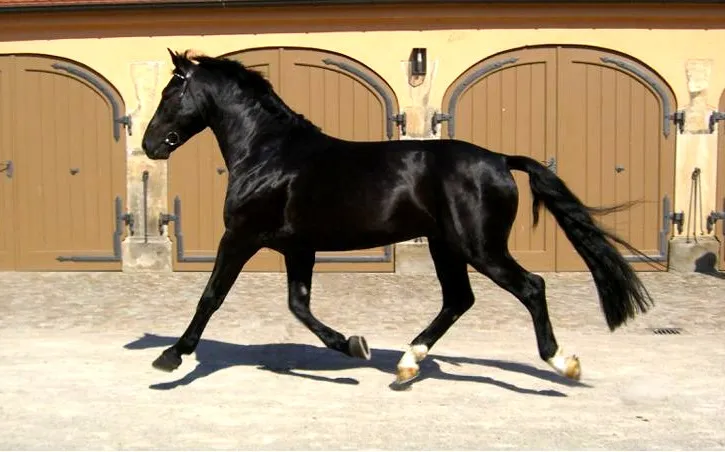Ostfriesen/Alt-Oldenburger horses are a versatile breed that come from Northern Germany.
They are known for their good temperament, sensible nature, and overall athleticism.
If you’re thinking of adding one of these horses to your stable, here’s what you need to know.
Ostfriesen/Alt-Oldenburger Horse Breed Info
Here are some of the key things you need to know about the Ostfriesen/Alt-Oldenburger horse:
| Height (size) | Up to 16.1 hands high |
| Colors | Black, bay, brown, chestnut, gray |
| Country of Origin | Germany |
| Common Uses | Sport, driving, general riding, mounted police |
Ostfriesen/Alt-Oldenburger Horse Facts & Information (Breed Profile)
Both the Alt-Oldenburger and the Ostfriesen belong to a category of horse breeds known as heavy warmbloods, the majority of which originated in continental Europe.
Because the same horse was developed in both East Frisia and the old grand duchy of Oldenburg in Germany’s far northwest, the breed has two names.
The name “Alt-Oldenburger,” which means “Old-Oldenburger,” just sets this horse apart from its sport-bred descendant, the modern Oldenburg.
Before the 17th century, Oldenburg’s horses were similar to those seen everywhere in Europe during the Middle Ages: small, sturdy farm horses, smooth-stepping saddle horses, faster “coursers,” and a few highly esteemed strong destriers.
As firearms became more accessible, however, massively armored knights and their heavy horses soon became the thing of the past.
During the 17th and 18th centuries, the Spanish horses that were the ancestors of the Andalusian, the Danish Fredriksborg, and the Neapolitan horse were quite popular among the German aristocracy.
The locals bred these stallions to their heavy mares, laying the foundations for what we now call the “baroque” type.
These stocky, mostly dark-colored horses would go on to contribute significantly to the development of the Groningen, Friesian, East Friesian, and Oldenburg breeds.
The Oldernburg horses gained public appreciation at the time of Anton Günther, Count of Oldenburg (1583-1667), who is claimed to have had a keen interest in horse breeding.
After traveling for many years, he brought back several horses from Spain, Italy, Turkey, and Poland that had particularly impressed him, and therefore some years later, Körung was born as the first Oldenburg stallion.
The careful assessment of potential herd sires was instituted in 1715 by Georg Albrecht, Prince of Ostfriese.
This practice was expanded to Oldenburg in 1755 with fantastic results, and those horses got to be in high demand for carriage driving.
It is safe to say that Georg Albrecht was ahead of his time since state-mandated stallion inspections didn’t begin until about a century later.
Oldenburg horse breeders established their own registration in 1861, and Ostfriesen horse breeders did the same in 1869, in response to the state’s restriction of stallion examinations in 1820.
Both sections used rigorous selection to accomplish similar breeding goals, even though not many breeders maintained pedigrees and many mares and stallions were unregistered until the 20th century.
Between 1880 and 1920 was the golden period of the elegant heavy carriage horse.
The breeding of Ostfriesen and Oldenburg horses had developed into a very profitable business.
The market for high-end horses abruptly transformed into the market for military remounts with the start of World War I.
Today, their numbers are low.
Their studbook, in contrast to the registries of the sport horses who came after them, is partially closed, and breeding complies to the standards that existed before to World War II.
If you’re interested in learning more about this fascinating breed, keep reading!
Alternative Names
“East Friesian”
Temperament/Personality
Calm and gentle disposition
Physical Characteristics
The head is large, with expressive eyes.
The neck is well-formed, medium length and muscular, and the shoulders are long and sloping.
The withers are well defined.
The back is strong and medium length.
The hindquarters are wide, and the croup is muscular and slightly sloped.
The legs are dry, and conformationally correct with strong joints.
The hooves are well-shaped.
It is a horse with a strong constitution, and expansive and efficient movements.
Colors
Black, bay, brown, chestnut, gray
Height (size)
Up to 16.1 hands high
Stallions
n/a
Mares
n/a
Weight
n/a
Blood Type
Warm
Common Uses
Sport, driving, general riding, mounted police
Health
n/a
Popular Traits
n/a
Feeding/Diet
n/a
Country of Origin
Germany
Ancestors
The old Spanish horses, Fredriksborg, Neapolitan horse
